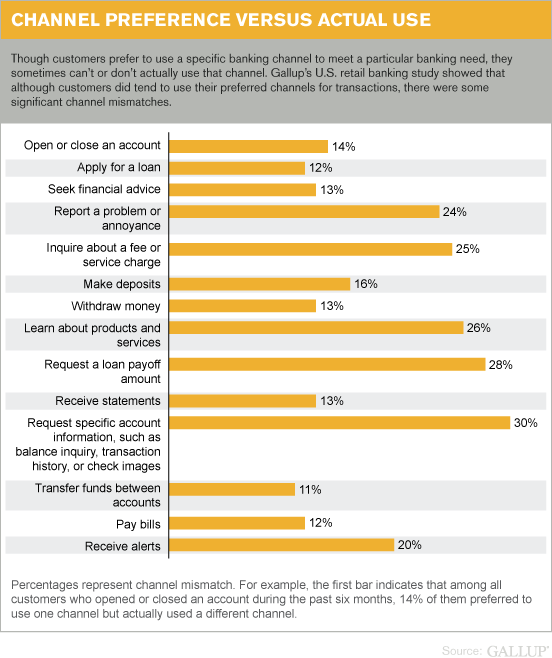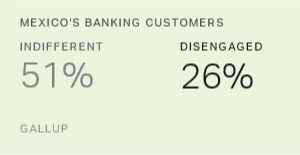The retail banking landscape has changed considerably in the wake of the global financial crisis. These changes have fundamentally altered the way banks generate revenue and profits.
The most intense transactions are more complex and emotionally charged; they are also more expensive for the bank.
Roughly 80% of customers in most large retail banks fail to turn a profit. Prior to the financial crisis, this business model was acceptable because banks could generate substantial profit from the 20% of customers who were profitable, while generating economies of scale from those who were not.
The Dodd-Frank legislation has changed this equation substantially. By curtailing banks' abilities to generate fee income from existing customers and by putting limits on other banking practices, these rules have forced retail banks to radically rethink their business models and the markets they serve. Banks have also had to reconsider the optimal mix of channels their customers use to interact with the bank and to transact their banking business -- from in-person in a branch or with a live agent on the phone to online, mobile, or email.
For example, a recent analysis suggests that a typical customer call to a call center in the United States costs $7.50 on average. The same call handled by an overseas agent costs less than one-third of that -- $2.35. But placing that call into an automated or interactive voice response system (AVR/IVR) reduces the cost to just 32 cents. It's hard to argue against numbers like that.
But lost in a purely cost-based analysis is a more important question: How do customers feel about using these various channels to transact their business? The answer is crucial because it directly affects the health of each customer's relationship with the bank. It also influences that customer's future banking behavior, which in turn affects key factors such as additional cross-sell, increased profitability, and reduced cost to service. In this article, the first in a two-part series, we'll explore how customer preferences for the banking channels they use affect key performance indicators such as satisfaction with that channel and engagement with the bank itself.
Channels customers prefer for 14 common banking needs
Customers have preferences for how they interact with a bank to meet various banking needs. To withdraw cash, one customer may prefer a face-to-face transaction with a live teller in a branch location while another customer may prefer to visit an ATM.
To better understand these channel preferences and how they affect customers' engagement with their bank, Gallup conducted a nationwide retail banking study that explored which channels customers prefer to use for 14 of their most common banking needs. In this study, we examined transaction channels from two perspectives:
- Service continuum: We considered these channels across a continuum that ranged from purely human transactions (such as face-to-face in a branch or with a live call center representative) through mixed modes (such as mail or ATM) to purely digital transactions (such as AVR/IVR, online/website, mobile banking, or email). The human-to-digital continuum is highly related to per-transaction cost; human transactions are the most expensive, and digital transactions are the least expensive.
- Customer preference: We also examined the data from a customer preference perspective, where the human-to-digital continuum is related to what we call the intensity of the transaction. The most intense transactions are more complex and emotionally charged; they are also more expensive for the bank. In contrast, the least intense transactions are relatively simple and have little emotional involvement; they are also less expensive for the bank.
Here is what we learned:
- To open or close an account, apply for a loan, or seek financial advice, about three out of four customers prefer interacting in person at a branch.
- To report a problem or inquire about a fee or service charge, customers prefer using a branch or interacting with a live call center representative.
- To make deposits, customers prefer using a branch. Customers who want to withdraw money prefer using a branch or an ATM.
- To learn about new products and services or request a loan payoff amount, the most preferred channels are: going online, using a branch, or speaking to a live call center representative.
- To request specific account information or transfer funds between accounts, most customers prefer going online, although a number of customers also prefer using a branch.
- Not surprisingly, to receive statements and pay bills, mail and online are the preferred channels. More customers prefer to receive statements by mail, while customers prefer the online channel to pay bills.
- To receive alerts, customers prefer using multiple channels, including online, mail, and email.

When channel preference and channel use don't match
The study also explored the consequences of mismatch, or when the channels customers prefer to use for a given transaction differ from the channels they actually use to complete their business with the bank. Overall, customers did tend to use their preferred channels for their banking transactions. However, there were some significant channel preference mismatches. The proportion of these mismatches ranged from 30% for requesting specific account information, such as balance inquiry, transaction history, or check images, to 11% for transferring funds between accounts.

When customers can't use the channel they prefer for a banking transaction, they are less satisfied with their experience than customers who used their preferred channel to meet their banking needs; they are also less engaged with the bank overall than customers who used their preferred channel. We observed significant declines in channel satisfaction for 12 of the 14 banking activities and significant declines in overall customer engagement for six of the 14. Highly emotional, complex, and expensive transactions, such as when customers open or close an account, apply for a loan, and seek financial advice, saw more decline in both channel satisfaction and overall engagement compared with other types of transactions.

Our analysis suggests that migrating customers from channels they prefer to use to channels they don't may lower their engagement with their bank. Banking executives may be less concerned about this drop in engagement among customers who are less profitable to the bank. But they may be seriously concerned about more valuable customer segments, where channel migration and the consequent declines in satisfaction and engagement could result in loss of revenue, profitability, and customer retention.
The second article of this series will explore these issues in greater detail and will suggest how banking executives can ease the process of transitioning customers into alternate channels.
